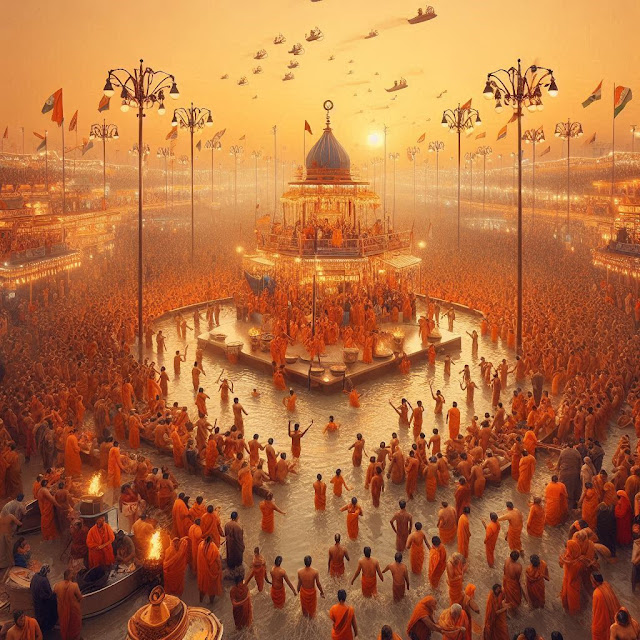The Maha Kumbh Mela: A Divine Confluence of History, Faith, and Culture
Maha Kumbh Mela is currently taking place in Prayagraj (formerly known as Allahabad), Uttar Pradesh. The festival commenced on January 13, 2025, and is expected to continue until February 26, 2025.
Historical Origins of the Kumbh Mela
The Kumbh Mela traces its origins to ancient Hindu scriptures and legends. The word “Kumbh” means pitcher or pot, and “Mela” translates to gathering or fair. The festival finds its roots in the mythological tale of the Samudra Manthan or the Churning of the Ocean of Milk, as narrated in the Puranas.
According to the legend, the devas (gods) and asuras (demons) jointly churned the ocean to obtain amrita, the nectar of immortality. When the nectar emerged, a fierce battle ensued between the two groups over its possession. During the struggle, drops of the nectar fell at four locations: Prayagraj (Allahabad), Haridwar, Ujjain, and Nashik. These places became sanctified, and the Kumbh Mela is held at each of them in rotation.
The earliest recorded mention of the Kumbh Mela is found in the Bhagavata Purana, Vishnu Purana, and other ancient texts. The festival gained prominence during the reign of Emperor Harshavardhana (606–647 CE), who is said to have organized a grand congregation at Prayagraj.
Religious and Spiritual Significance
At the heart of the Maha Kumbh Mela lies the belief in the purifying power of water. The confluence of the sacred rivers Ganga, Yamuna, and the mythical Saraswati at Prayagraj is known as the Triveni Sangam, a place of immense spiritual potency. Bathing in these waters during the auspicious period of the Kumbh Mela is believed to cleanse sins and grant moksha (liberation).
The festival also serves as a spiritual confluence where saints, sadhus, and ascetics from diverse sects come together to share their wisdom. The presence of Naga Sadhus, with their ash-covered bodies and austere practices, is one of the most iconic aspects of the Kumbh Mela. They emerge from their hermitages to bless devotees and perform rituals.
Astrology plays a crucial role in determining the timing of the festival. The dates are chosen based on specific planetary alignments, particularly the positions of Jupiter, the Sun, and the Moon. These celestial configurations are believed to enhance the sanctity of the pilgrimage.
Cultural and Social Dimensions
Beyond its religious significance, the Maha Kumbh Mela is a vibrant cultural phenomenon. It showcases the diversity of Indian traditions, with pilgrims from various regions, languages, and cultural backgrounds coming together in a spirit of unity.
Cultural programs, including music, dance, and theatrical performances, add to the festival’s charm. Traditional art forms and handicrafts are displayed, offering a glimpse into India’s rich heritage. The festival also serves as a platform for spiritual discourses, debates, and intellectual exchanges.
The Akhara Procession, where different sects of sadhus parade to the river for a holy dip, is a spectacle in itself. The akharas, or monastic orders, represent various schools of Hindu philosophy and play a central role in the festival’s organization.
Evolution Over the Centuries
The Kumbh Mela has evolved significantly over time. In ancient and medieval periods, it was primarily a gathering of saints and ascetics. Over the centuries, it became a mass movement, attracting pilgrims from all walks of life.
Modern technology and infrastructure have transformed the scale and management of the event. The Uttar Pradesh government, for instance, makes extensive arrangements for the Maha Kumbh Mela at Prayagraj, including the construction of temporary cities, sanitation facilities, and security measures. Innovations such as AI-enabled cameras, drones, and digital platforms have enhanced the efficiency of crowd management and safety.
Despite these advancements, the essence of the festival remains unchanged—a timeless celebration of faith and devotion.
Global Impact and Recognition
The Maha Kumbh Mela has garnered global attention as the largest human gathering on Earth. In 2017, UNESCO recognized it as an Intangible Cultural Heritage of Humanity, highlighting its significance as a living tradition.
The festival attracts international pilgrims and spiritual seekers, contributing to cultural exchange and tourism. It has also inspired academic studies, documentaries, and artistic creations, further cementing its place in the global consciousness.
Challenges and Sustainability
Managing the Maha Kumbh Mela is no small feat. The influx of millions of people poses logistical, environmental, and health challenges. Ensuring the safety, hygiene, and well-being of pilgrims requires meticulous planning and coordination.
Environmental concerns, particularly the pollution of the rivers, have prompted initiatives to make the festival more sustainable. Efforts include river-cleaning drives, waste management systems, and eco-friendly practices. These measures aim to preserve the sanctity of the event for future generations.
The Maha Kumbh Mela is more than just a religious festival; it is a celebration of humanity’s quest for spiritual connection and self-realization. Rooted in ancient traditions yet adapting to contemporary times, it exemplifies the resilience and continuity of India’s cultural heritage.
For millions, the Maha Kumbh Mela is a journey of faith and hope, a chance to cleanse the soul and embrace a higher purpose. It stands as a testament to the power of belief, the strength of community, and the timeless appeal of spiritual pursuits.
As the 2025 Maha Kumbh Mela unfolds in Prayagraj, it invites us all to reflect on the deeper truths of existence and the universal bonds that unite us. It is not merely a gathering of people—it is a confluence of history, devotion, and the eternal flow of the human spirit.



Comments